The Engineering Properties and Microscopic Characteristics of High-Liquid-Limit Soil Improved with Lignin
Abstract
:1. Introduction
2. Materials and Methods
2.1. Materials
2.2. Sample Preparation and Testing Program
2.2.1. Sample Preparation
2.2.2. Testing Program
2.3. Testing Methods
2.3.2. Atterberg Limits Test
2.3.3. Compaction Test
2.3.4. UCS Test
2.3.5. CBR Test
2.3.6. Resilient Modulus Test
2.3.7. SEM/EDS Test
2.3.8. FTIR Test
3. Results and Discussion
3.1. Physicochemical Tests
3.1.1. pH Value
3.1.2. Atterberg Limits
3.1.3. Compaction Characteristics
3.2. Mechanical Properties
3.3. Microstructure Characteristic
3.4. Discussion on the Mechanism of Lignin Improvement
4. Conclusions and Outlook
- (1)
- Lignin had little effect on the pH of the improved soil. With the increase in lignin content, the pH value of the improved soil decreased gradually and then stabilized at about 7.0. Compared with the traditional chemical stabilizer (quicklime), lignin has obvious advantages for the ecological environment.
- (2)
- With the increase in lignin content, the liquid limit, plastic limit, and plasticity index of the improved soil decreased first and then increased and reached a minimum value when the lignin content was 3%.
- (3)
- When the lignin content was 3%, the dry density, UCS, CBR, and resilient modulus of the improved soil all showed maximum values.
- (4)
- The improvement mechanism of lignin on soil can be attributed to ion exchange, hydrogen bonding, covalent bonding, and electrostatic attraction. Under the combined action of the above factors, a polymer with cementing properties was formed between lignin and clay minerals, which improved the structural stability of the soil by encapsulating soil particles and filling pores and showed the enhancement of engineering properties of the soil on a macro level.
Author Contributions
Funding
Institutional Review Board Statement
Informed Consent Statement
Data Availability Statement
Conflicts of Interest
References
- Lu, Z.; Fang, R.; Zhan, Y.; Yao, H. Study on the dynamic deformation of road high liquid limit subgrade soil. Adv. Civ. Eng. 2019, 2019, 4084983. [Google Scholar] [CrossRef]
- Wang, Y.; Zhang, H.; Zhang, Z. Experimental study on mechanics and water stability of high liquid limit soil stabilized by compound stabilizer: A sustainable construction perspective. Sustainability 2021, 13, 5681. [Google Scholar] [CrossRef]
- Wang, J.; Wu, L.; Feng, R. An experimental case study of a high-liquid-limit lateritic soil with its application in road construction. Road Mater. Pavement Des. 2017, 18, 1423–1433. [Google Scholar] [CrossRef]
- Latifi, N.; Rashid, A.S.A.; Siddiqua, S.; Horpibulsuk, S. Micro-structural analysis of strength development in low- and high swelling clays stabilized with magnesium chloride solution—A green soil stabilizer. Appl. Clay Sci. 2015, 118, 195–206. [Google Scholar] [CrossRef]
- Gautam, S.; Hoyos, L.R.; He, S.; Prabakar, S.; Yu, X. Chemical treatment of a highly expansive clay using a liquid ionic soil stabilizer. Geotech. Geol. Eng. 2020, 38, 4981–4993. [Google Scholar] [CrossRef]
- Guo, Q.; Wei, M.; Du, G.; Xue, H.; Liu, S. Research on strength behavior and micro-mechanism of AMC stabilized high liquid limit clay. J. China Univ. Min. Technol. 2018, 47, 838–845. [Google Scholar]
- Ikeagwuani, C.C.; Nwonu, D.C. Emerging trends in expansive soil stabilization: A review. J. Rock Mech. Geotech. Eng. 2019, 11, 423–440. [Google Scholar] [CrossRef]
- Sariosseiri, F.; Muhunthan, B. Effect of cement treatment on geotechnical properties of some Washington State soils. Eng. Geol. 2009, 104, 119–125. [Google Scholar] [CrossRef]
- Shihab, A.M.; Abbas, J.M.; Ibrahim, A.M. Effects of temperature in different initial duration time for soft clay stabilized by fly ash based geopolymer. Civ. Eng. J. 2018, 4, 2082–2096. [Google Scholar] [CrossRef] [Green Version]
- Liu, S.; Zhang, T.; Cai, G.; Li, J.; Jie, D. Research progress of soil stabilization with lignin from bio-energy by-products. China J. Highw. Transp. 2014, 27, 1–10. [Google Scholar]
- Latifi, N.; Suksun, H.; Meehan, C.L.; Abd Majid, M.Z.; Tahir, M.M.; Mohamad, E.Z. Improvement of problematic soils with biopolymer—An environmentally friendly soil stabilizer. J. Mater. Civ. Eng. 2017, 29, 04016204. [Google Scholar] [CrossRef]
- Zhang, T.; Cai, G.; Liu, S.; Puppala, A.J. Engineering properties and microstructural characteristics of foundation silt stabilized by lignin-based industrial by-product. KSCE J. Civ. Eng. 2016, 20, 2725–2736. [Google Scholar] [CrossRef]
- Fatehi, H.; Abtahi, S.M.; Hashemolhosseini, H.; Hejazi, S.M. A novel study on using protein based biopolymers in soil strengthening. Constr. Build. Mater. 2018, 167, 813–821. [Google Scholar] [CrossRef]
- Kamath, M.; Prashant, S.; Kumar, M. Micro-characterisation of alkali activated paste with fly ash-GGBS-metakaolin binder system with ambient setting characteristics. Constr. Build. Mater. 2021, 277, 122323. [Google Scholar] [CrossRef]
- Boquera, L.; Olacia, E.; Fabiani, C.; Pisello, A.L.; D’Alessandro, A.; Ubertini, F.; Cabeza, L.F. Thermo-acoustic and mechanical characterization of novel bio-based plasters: The valorisation of lignin as by-product from biomass extraction for green building applications. Constr. Build. Mater. 2021, 278, 122373. [Google Scholar] [CrossRef]
- Mavroulidou, M. Use of waste paper sludge ash as a calcium-based stabiliser for clay soils. Waste Manag. Res. 2018, 36, 1066–1072. [Google Scholar] [CrossRef]
- Ramdas, V.M.; Mandree, P.; Mgangira, M.; Mukaratirwa, S.; Lalloo, R.; Ramchuran, S. Review of current and future bio-based stabilisation products (enzymatic and polymeric) for road construction materials. Transp. Geotech. 2021, 27, 100458. [Google Scholar] [CrossRef]
- Pérez, I.P.; Pasandín, A.M.R.; Pais, J.C.; Pereira, P.A.A. Use of lignin biopolymer from industrial waste as bitumen extender for asphalt mixtures. J. Clean. Prod. 2019, 220, 87–98. [Google Scholar] [CrossRef]
- Liu, Y.; Zheng, W.; Wang, Q.; Cao, C.; Chang, M.; Rocchi, I. Evaluating sulfur-free lignin as a sustainable additive for soil improvement against frost resistance. J. Clean. Prod. 2020, 251, 119504. [Google Scholar] [CrossRef]
- Di Matteo, L.; Bulletti, L.; Capecchi, E.; La Viola, A.; Piccinino, D.; Piscopo, V. Perspectives of using lignin as additive to improve the permeability of in-situ soils for barrier materials in landfills. Sustainability 2020, 12, 5197. [Google Scholar] [CrossRef]
- Park, G.W.; Gong, G.; Joo, J.C.; Song, J.; Lee, J.; Lee, J.P.; Kim, H.T.; Ryu, M.H.; Sirohi, R.; Zhuang, X.; et al. Recent progress and challenges in biological degradation and biotechnological valorization of lignin as an emerging source of bioenergy: A state-of-the-art review. Renew. Sustain. Energy Rev. 2022, 157, 112025. [Google Scholar] [CrossRef]
- Uwaoma, R.C.; Seheri, M.P.; Strydom, C.A.; Bunt, J.R.; Matjie, R.H. The influence of calcium lignosulphonate addition on non-isothermal pyrolysis and gasification of demineralized bituminous coal fines. Thermochim. Acta 2022, 707, 179096. [Google Scholar] [CrossRef]
- Surdahl, R.W.; Woll, J.H.; Marquez, H.R. Stabilization and dust control at the Buenos Aires National Wildlife Refuge, Arizona. Transp. Res. Rec. 2007, 1, 312–321. [Google Scholar] [CrossRef]
- Santoni, R.L.; Tingle, J.S.; Webster, S.L. Stabilization of silty sand with nontraditional additives. Transp. Res. Rec. 2002, 61–72. [Google Scholar] [CrossRef] [Green Version]
- Tingle, J.S.; Santoni, R.L. Stabilization of clay soils with nontraditional additives. Transp. Res. Rec. 2003, 72–84. [Google Scholar] [CrossRef]
- Ceylan, H.; Gopalakrishnan, K.; Kim, S. Soil Stabilization with bioenergy coproduct. Transp. Res. Rec. 2010, 130–137. [Google Scholar] [CrossRef] [Green Version]
- Chen, Q.; Indraratna, B. Deformation behavior of lignosulfonate-treated sandy silt under cyclic loading. J. Geotech. Geoenvironmental Eng. 2015, 141, 06014015. [Google Scholar] [CrossRef]
- Indraratna, B.; Muttuvel, T.; Khabbaz, H.; Armstrong, R. Predicting the erosion rate of chemically treated soil using a process simulation apparatus for internal crack erosion. J. Geotech. Geoenviron. Eng. 2008, 134, 837–844. [Google Scholar] [CrossRef]
- Vinod, J.S.; Indraratna, B.; Al Mahamud, M.A. Stabilisation of an erodible soil using a chemical admixture. Proc. Inst. Civ. Eng. Ground Improv. 2010, 163, 43–51. [Google Scholar] [CrossRef] [Green Version]
- Kim, S.; Gopalakrishnan, K.; Ceylan, H. Moisture susceptibility of subgrade soils stabilized by lignin-based renewable energy coproduct. J. Transp. Eng. 2012, 138, 1283–1290. [Google Scholar] [CrossRef] [Green Version]
- Zhang, T.; Liu, S.; Cai, G.; Li, J.; Jie, D. Experimental study on relationship between thermal and mechanical properties of treated silt by lignin. Chin. J. Geotech. Eng. 2015, 37, 1876–1885. [Google Scholar]
- Zhang, T.; Cai, G.; Liu, S.; Liu, J.; Jie, D. Research on stabilization microcosmic mechanism of lignin based industrial by-product treated subgrade silt. Rock Soil Mech. 2016, 37, 1666–1672. [Google Scholar]
- Zhang, T.; Liu, S.; Zhan, H.; Ma, C.; Cai, G. Durability of silty soil stabilized with recycled lignin for sustainable engineering materials. J. Clean. Prod. 2020, 248, 119293. [Google Scholar] [CrossRef]
- Liu, S.; Zhang, T.; Cai, G. Research on technology and engineering application of silt subgrade solidified by lignin-based industrial by-product. China J. Highw. Transp. 2018, 31, 1–11. [Google Scholar]
- He, Z.; Fan, H.; Wang, J.; Liu, G.; Wang, Z.; Yu, J. Experimental study of engineering properties of loess reinforced by lignosulfonate. Rock Soil Mech. 2017, 38, 731–739. [Google Scholar]
- Hou, X.; Ma, W.; Li, G.; Mu, Y.; Zhou, Z.; Wang, F. Influence of lignosulfonate on mechanical properties of Lanzhou loess. Rock Soil Mech. 2017, 38, 18–26. [Google Scholar]
- Liu, W.; Zhang, E. Compression characteristics of dredging soil solidified by lignin. J. Yangtze River Sci. Res. Institute 2017, 34, 83–86. [Google Scholar]
- Kong, X.; Song, S.; Wang, M.; Zhao, Q. Experimental research of low liquid limit silt stabilized by lignin in the flooding area of yellow river. Geotech. Geol. Eng. 2019, 37, 5211–5217. [Google Scholar] [CrossRef]
- Ta’negonbadi, B.; Noorzad, R. Stabilization of clayey soil using lignosulfonate. Transp. Geotech. 2017, 12, 45–55. [Google Scholar] [CrossRef]
- Ministry of Transport of the People’s Republic of China. Test Methods of Soils for Highway Engineering; JTG E40-2007; Press of China: Beijing, China, 2007. [Google Scholar]
- Coates, J. Interpretation of infrared spectra, a practical approach. In Encyclopedia of Analytical Chemistry; Meyers, R.A., Ed.; John Wiley & Sons, Ltd.: Chichester, UK, 2006; p. a5606. [Google Scholar]
- Zhang, R.; Xiao, Y.; Liu, C.; Zheng, J. Control standards for degree of compaction of high liquid limit soil subgrade considering effects of adsorbed bound water. China J. Highw. Transp. 2020, 33, 32–40+50. [Google Scholar]
- Ye, H.; Zhang, Y.; Yu, Z.; Mu, J. Effects of cellulose, hemicellulose, and lignin on the morphology and mechanical properties of metakaolin-based geopolymer. Constr. Build. Mater. 2018, 173, 10–16. [Google Scholar] [CrossRef]
- Alazigha, D.P.; Indraratna, B.; Vinod, J.S.; Heitor, A. Mechanisms of stabilization of expansive soil with lignosulfonate admixture. Transp. Geotech. 2018, 14, 81–92. [Google Scholar] [CrossRef] [Green Version]
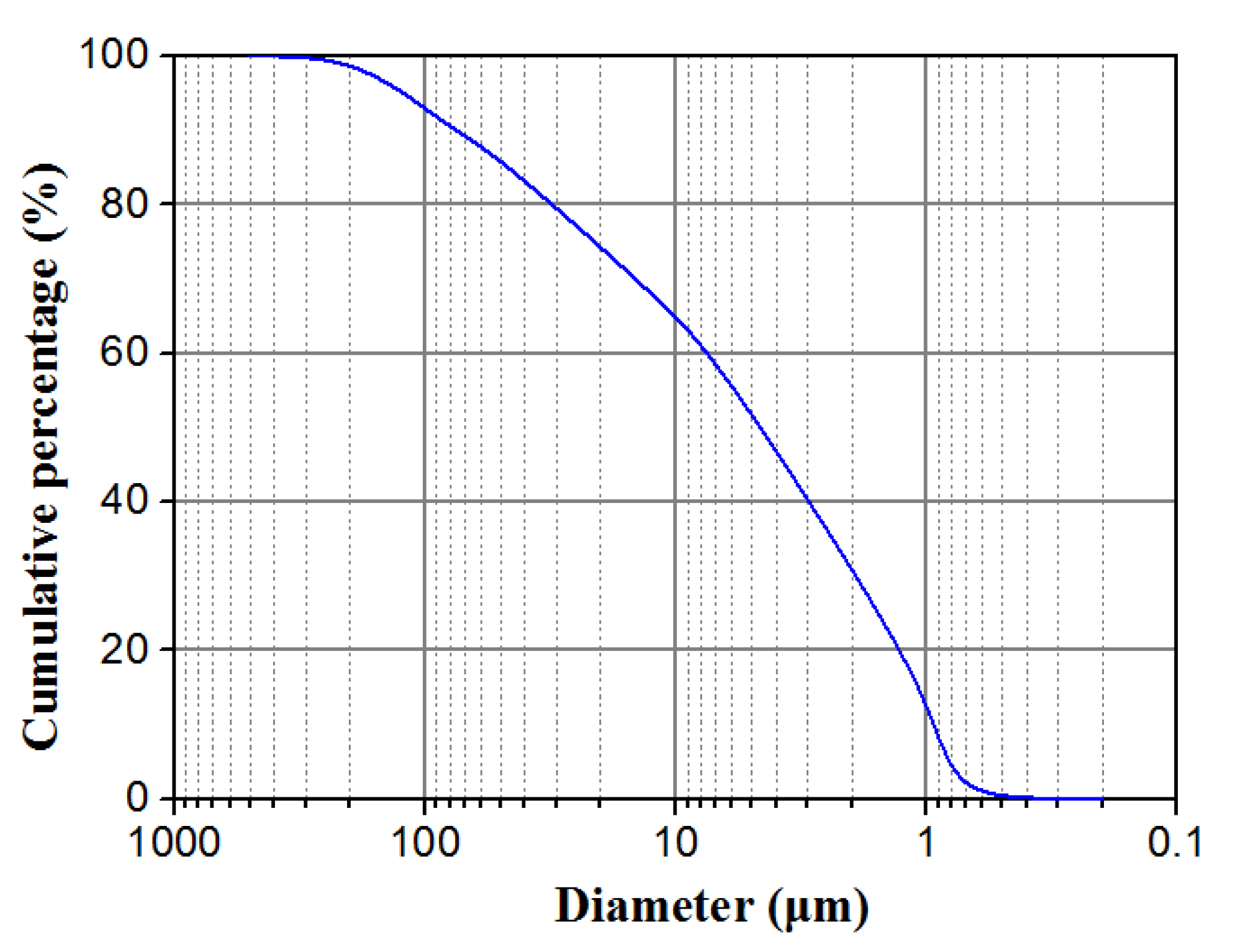
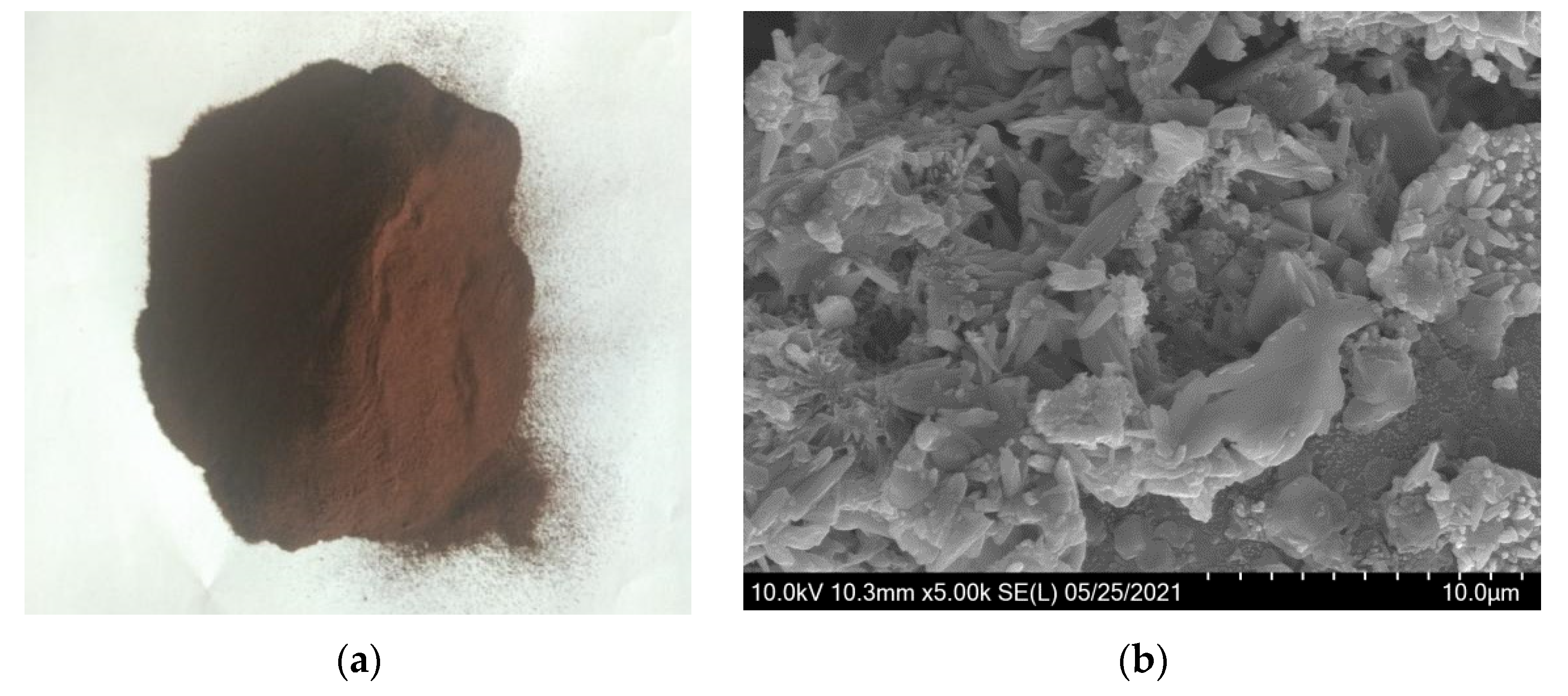

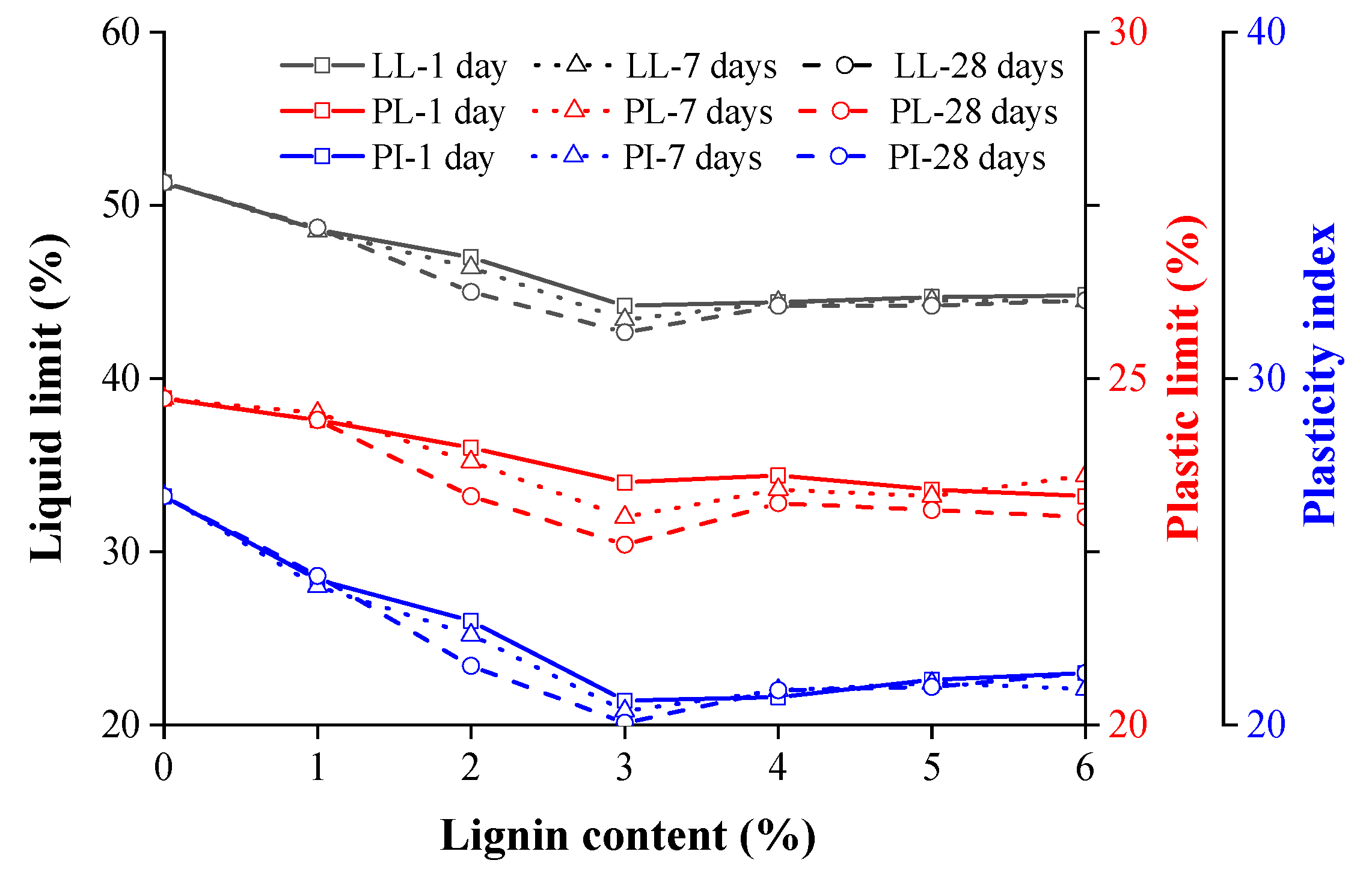
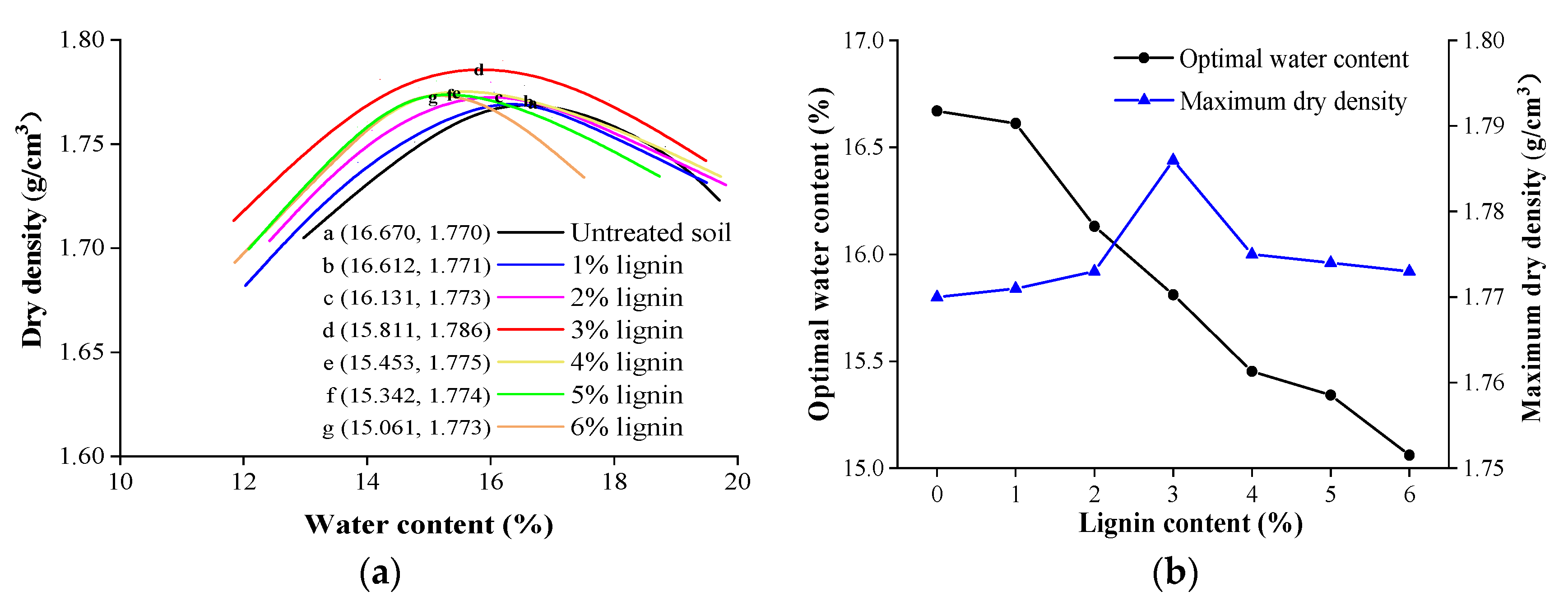
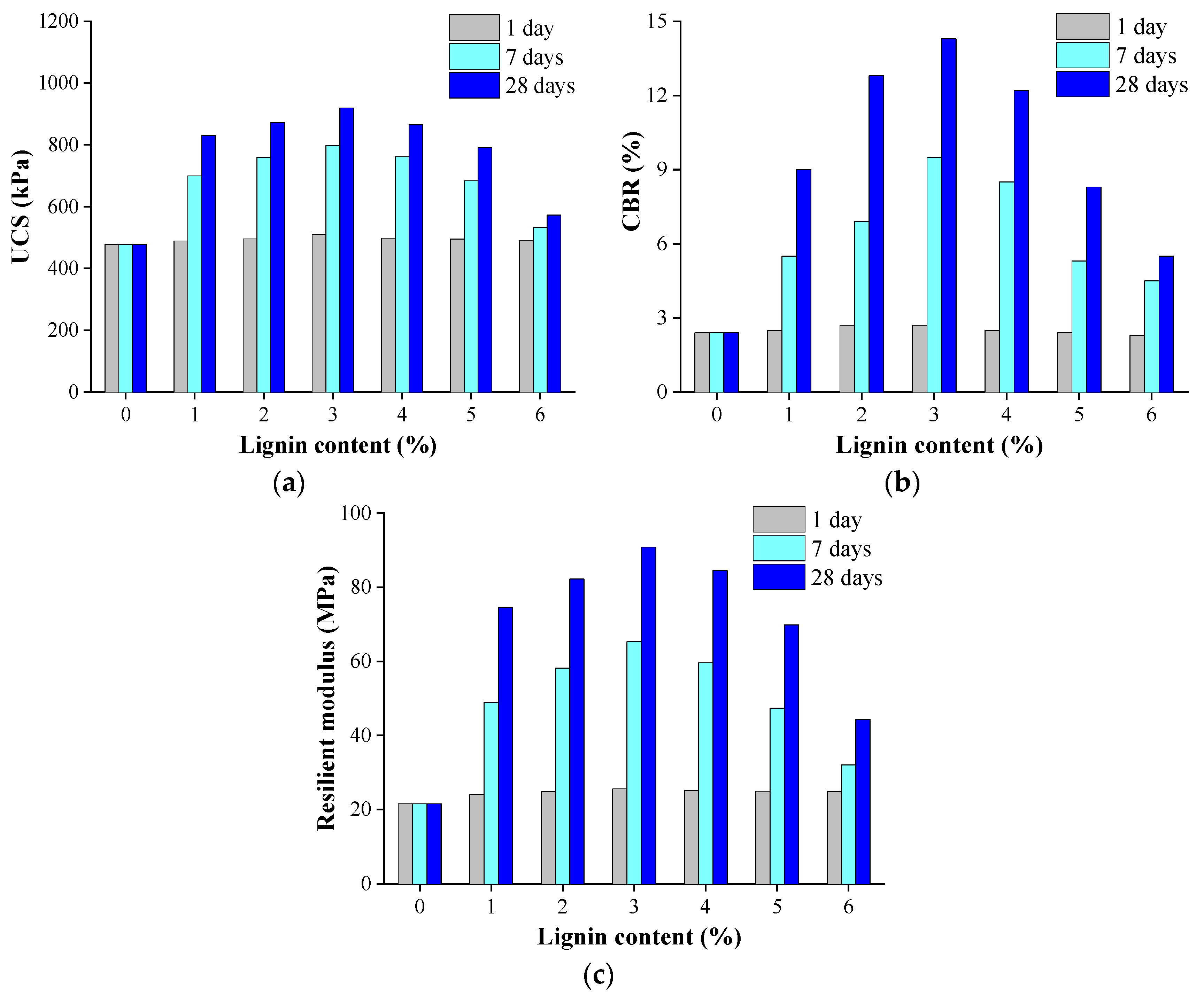
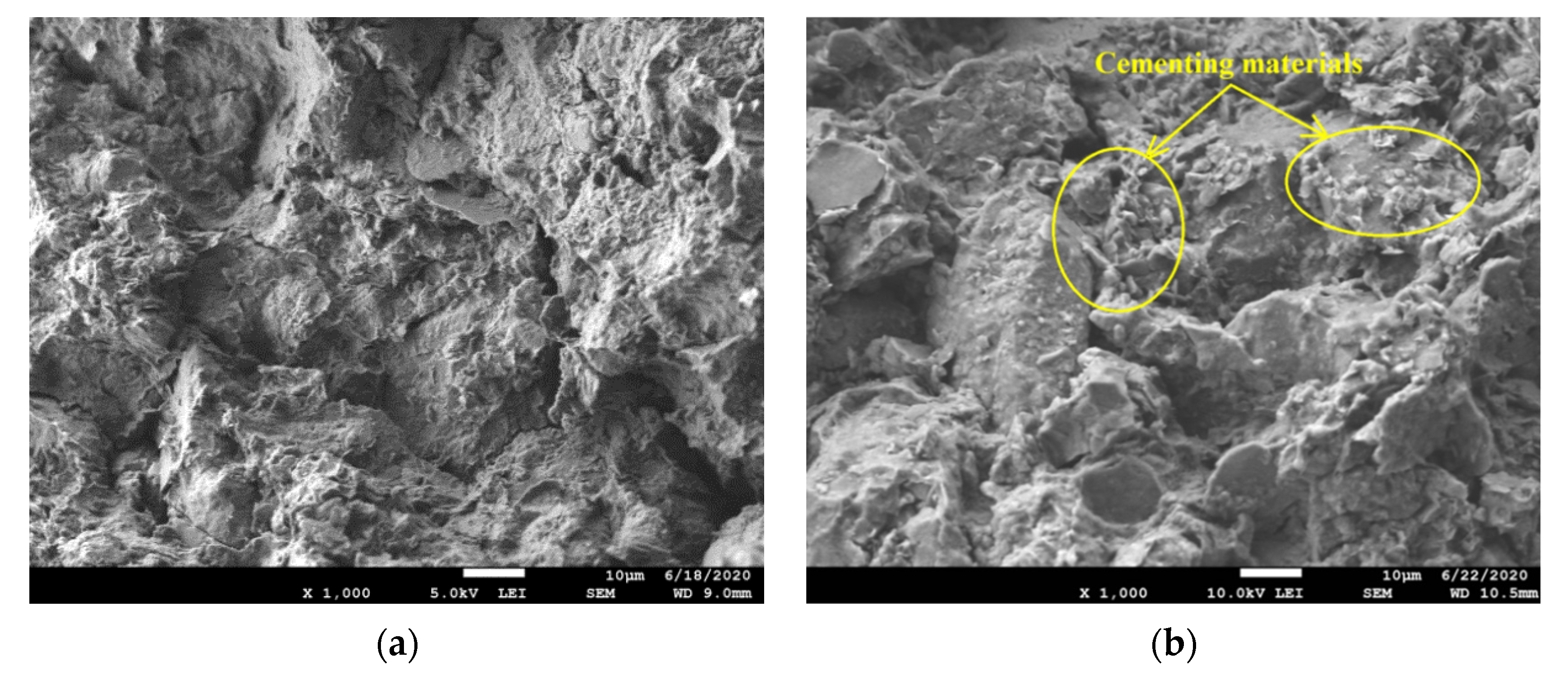
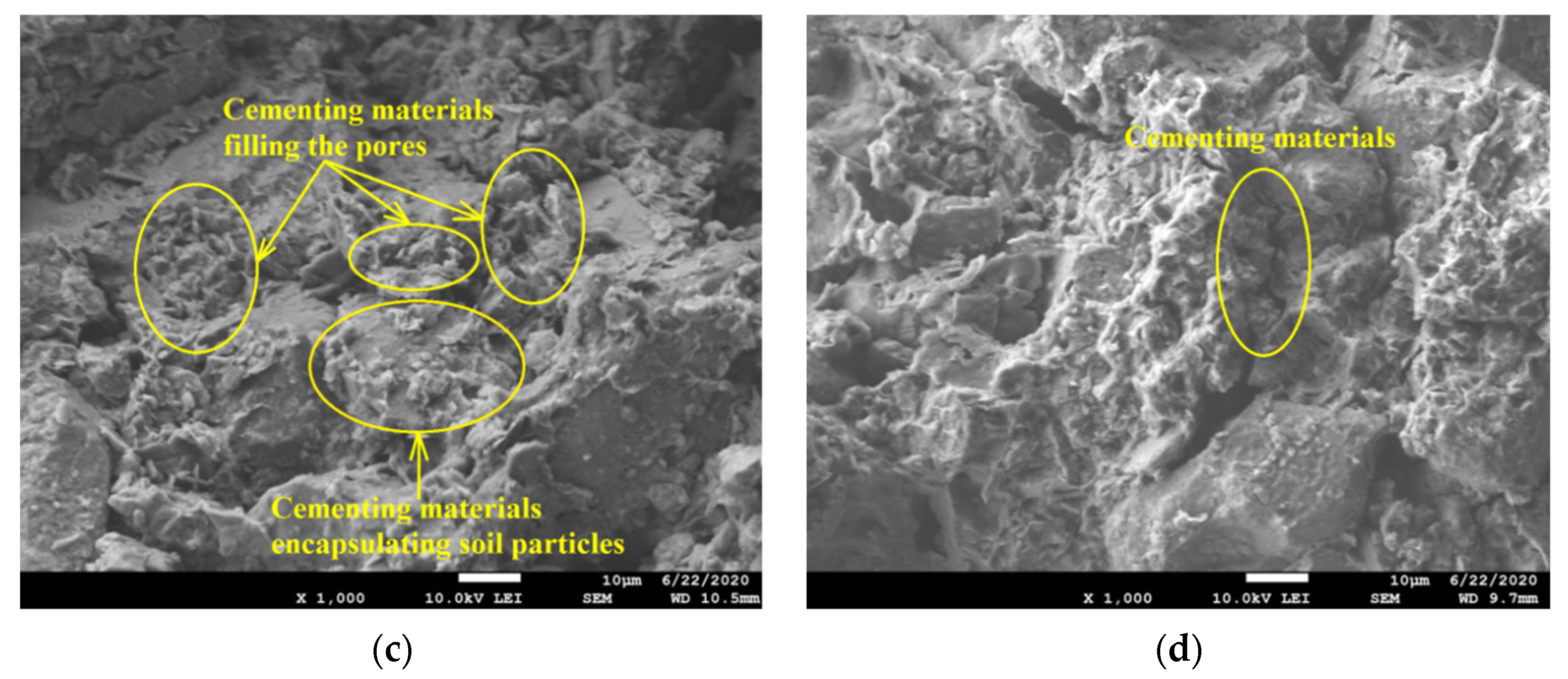




| Property | Value |
|---|---|
| Natural water content (%) | 23.6 |
| Liquid limit (%) | 51.31 |
| Plastic limit (%) | 24.71 |
| Plasticity index | 26.6 |
| Clay (<0.002 mm) (%) | 31.2 |
| Silt (0.002–0.075 mm) (%) | 58.7 |
| Sand (0.075–2 mm) (%) | 10.1 |
| Maximum dry density (g/cm3) | 1.77 |
| Optimal water content (%) | 16.67 |
| pH | 8.0 |
| Test Type | Lignin Content (%) a | Curing Time (days) |
|---|---|---|
| pH test b | 0, 1, 2, 3, 4, 5, 6, 9, 12 | 1, 28 |
| Atterberg limits | 0, 1, 2, 3, 4, 5, 6 | 1, 7, 28 |
| Compaction test | 0, 1, 2, 3, 4, 5, 6 | 1 |
| UCS test c | 0, 1, 2, 3, 4, 5, 6 | 1, 7, 28 |
| CBR test c | 0, 1, 2, 3, 4, 5, 6 | 1, 7, 28 |
| Resilient modulus c | 0, 1, 2, 3, 4, 5, 6 | 1, 7, 28 |
| SEM | 0, 1, 3, 5 | 28 |
| EDS | 0, 3 | 28 |
| FTIR | 0, 3 | 28 |
Publisher’s Note: MDPI stays neutral with regard to jurisdictional claims in published maps and institutional affiliations. |
© 2022 by the authors. Licensee MDPI, Basel, Switzerland. This article is an open access article distributed under the terms and conditions of the Creative Commons Attribution (CC BY) license (https://creativecommons.org/licenses/by/4.0/).
Share and Cite
Kong, X.; Wang, G.; Liang, Y.; Zhang, Z.; Cui, S. The Engineering Properties and Microscopic Characteristics of High-Liquid-Limit Soil Improved with Lignin. Coatings 2022, 12, 268. https://doi.org/10.3390/coatings12020268
Kong X, Wang G, Liang Y, Zhang Z, Cui S. The Engineering Properties and Microscopic Characteristics of High-Liquid-Limit Soil Improved with Lignin. Coatings. 2022; 12(2):268. https://doi.org/10.3390/coatings12020268
Chicago/Turabian StyleKong, Xianghui, Gaoqiang Wang, Yunpeng Liang, Zhibin Zhang, and Shuai Cui. 2022. "The Engineering Properties and Microscopic Characteristics of High-Liquid-Limit Soil Improved with Lignin" Coatings 12, no. 2: 268. https://doi.org/10.3390/coatings12020268
APA StyleKong, X., Wang, G., Liang, Y., Zhang, Z., & Cui, S. (2022). The Engineering Properties and Microscopic Characteristics of High-Liquid-Limit Soil Improved with Lignin. Coatings, 12(2), 268. https://doi.org/10.3390/coatings12020268








